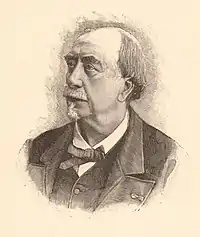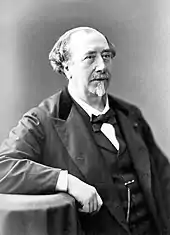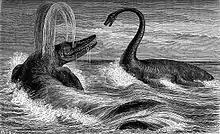

Louis Figuier (15 February 1819 in Montpellier – 8 November 1894 in 9th arrondissement of Paris)[1] was a French scientist and writer. He was the nephew of Pierre-Oscar Figuier and became Professor of chemistry at L'Ecole de pharmacie of Montpellier. Louis Figuier was married to French writer Louise Juliette Bouscaren.[2]
Career
Figuier became Doctor of Medicine (1841), agrégé of pharmacology, chemistry (1844–1853) and physics and gained his PhD in (1850). Figuier was appointed professor at L'Ecole de Pharmacie of Paris after leaving Montpellier. In his research he found himself opposed to Claude Bernard; as a result of this conflict, he abandoned his research to devote himself to popular science. He edited and published a yearbook from 1857 to 1894 – L'Année scientifique et industrielle (or Exposé annuel des travaux) – in which he compiled an inventory of the scientific discoveries of the year (it was continued after his death until 1914). He was the author of numerous successful works: Les Grandes inventions anciennes et modernes (1861), Le Savant du foyer (1862), La Terre avant le déluge (1863) illustrated by Édouard Riou, La Terre et les mers (1864), Les Merveilles de la science (1867–1891).
He wrote extensively on the subject of photography, including it in his study on the marvels of nineteenth-century science, and also writing a self-standing book on the subject.[3]
Influenced by Charles Lyell's Geological Evidences of the Antiquity of Man of 1863, the 1867 second edition of La Terre avant le déluge abandoned the Garden of Eden shown in the first edition, and included dramatic illustrations of savage men and women wearing animal skins and wielding stone axes.[4]
Main works

- La terre avant le deluge, 1863, 2nd. edition 1867
- English translation, World Before the Deluge,[5] 1865
- Swedish translation by Carl Hartman, Jorden före syndafloden, 1868, based on the 5th French edition
- Vies des savants illustres de l'antiquité (Lives of the Illustrious Scholars of Antiquity), 1866
- Vies des savants illustres du moyen age (Lives of the Illustrious Scholars of the Middle Ages), 1867
- The Vegetable World, 1867
- Vies des savants illustres de la Renaissance (Lives of the Illustrious Scholars of the Renaissance), 1868
- The Ocean World, 1868
- The Insect World, 1868
- Reptiles and Birds, 1869
- Vies des savants illustres du XVIIe siècle (Lives of the Illustrious Scholars of the 17th century), 1869
- Vies des savants illustres du XVIIIe siècle (Lives of the Illustrious Scholars of the 18th century), 1870
- Primitive Man, 1871
- The human race, 1872[6][7]
- La Photographie, 1889
- Les Merveilles De La Science, Ou Description Populaire Des Inventions Modernes, (The wonders of science or a popular description of modern inventions), 1891
Footnotes
- ↑ Death record p. 25/29 Archiv de Paris Cote V4E 8812
- ↑ "Juliette Figuier (1829-1879)". data.bnf.fr. Retrieved 29 September 2020.
- ↑ Boisjoly, François (2006). La photo-carte : portrait de la France du XIXe siècle. impr. Chirat). Lyon: Lieux dits. p. 159. ISBN 2-914528-23-X. OCLC 421386112.
{{cite book}}: CS1 maint: date and year (link) - ↑ Browne 2002, pp. 218, 515.
- ↑ "Before the Flood". geology.19thcenturyscience.org.
- ↑ "The human race". Internet Archive.
- ↑ "The Project Gutenberg eBook of The Human Race, by Louis Figuier". gutenberg.org.
References
- Browne, E. Janet (2002), Charles Darwin: vol. 2 The Power of Place, London: Jonathan Cape, ISBN 0-7126-6837-3
External links
- Works by Louis Figuier at Project Gutenberg
- Works by or about Louis Figuier at Internet Archive
- Figuier's Merveilles de la science (6 vols., 1867-1891) - digital facsimiles from Linda Hall Library
- A selection of high-resolution scans from Figuier's L'homme primitif, Primitive man, and Terre avant deluge - from Linda Hall Library